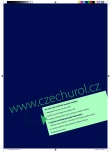Extracorporeal shock-wave litothripsy – 4 year experience with electromagnetic litotripter Urontech URO-EMX
Authors:
Jakub Musil 1; Daniel Bulíř 1; Jan Jandejsek 1
Authors‘ workplace:
Urologické oddělení Oblastní nemocnice Kolín a. s.
1
Published in:
Ces Urol 2014; 18(3): 234-239
Category:
Original article
Overview
Aim:
One hundred seventy one patients were treated by extracorporal shock-wave lithotrypsy (ESWL) at the Department of Urology, Regional hospital Kolín, between years 2010 and 2013. The aims of this communication are to analyse the success and complication rates of the treatment using this method. In addition we compared efficiency of treatment in group of patiens with and without ureteral stent.
Methods:
Retrospective analysis of treatment outcomes in patiens, treated by ESWL in a period between 2010 and 2013.
Results:
The stone-free rate was achieved in 58.5% patiens. The ESWL without stent was successful in 67.2% patiens. Efficiency with stent was succesfull in 53.9% of cases. The total rate of complications was 3.2%, with serious complications (degree II of Clavien-Dindo clasification) developing in 0.71% patients.
Conclusion:
Extracorporeal shock-wave lithothripsy, using Urontech URO-EMX lithotripter, represents effective method for treatment of nephrolithiasis and proximal uretolithiasis. Total efficiency of the procedure was lower in group of patiens with ureteral stent.
Key words:
extracorporeal shock-wave litothripsy, nephrolithiasis, subcapsular haematoma, ureterolithiasis.
Sources
1. Türk C, Knoll T, et al. Guidelines on Urolithiasis. EAU, update March 2013; 25–31.
2. Fógel K. Fyzikální základy extrakorporální litotrypse. Ces Urol 2010; 14(2): 73–80.
3. Connors BA, Evan AP, Blomgren PM, et al. Effect of initial shock wave voltage on shock wave lithotripsy-induced lesion size during step-wise voltage ramping. BJU Int 2009; 103(1): 104–107.
4. Broďák M, Košina J, Holub L, Navrátil P, Romžová M, et al. Antibiotická profylaxe v urologii. Urol pro Praxi 2010; 11(2): 97–100.
5. Tolley DA, et al. First UK consensus conference on lithotriptor terminology 1989. Br J Urol 1991; 67(1): 9–12.
6. Dhar NB, Thornton J, Karafa MT, et al. A multivariate analysis of risk factors associated with subcapsular hematoma formation following electromagnetic shock wave lithotripsy. J Urol 2004; 172(6 Pt 1): 2271–2274.
7. Poršová M, Kaplan O, Pabišta R, Kolombo I, Porš J, et al. Ruptura sleziny, vzácná komplikace po LERV. Urolog. pro Praxi 2005; 6(5): 213–215.
8. Ürge T, Kouba J, Jambura J, Hora M, Havel V, Skalický T. Ruptura ledviny jako komplikace extrakorporální litotrypse pyelolitiázy, Ces Urol 2009; 13(3): 217–222.
9. Dindo D, Demartines N, Clavien PA. Classification of surgical complications, a new proposal with evaluation in a cohort of 6336 patients and results of a survey. Ann Surg 2004; 240(2): 205–213.
10. Petřík A, Alterová E, Fiala M, Novák J, Záťura F. Vliv stentingu na desintegraci ureterolitiázy in vivo. Ces Urol 2006; 10(1): 59–63.
11. Musa AA. Use of double-J stents prior to extracorporeal shock wave lithotripsy is not beneficial: results of a prospective randomized study. Int Urol Nephrol 2008; 40(1): 19–22.
12. Petřík A. Diagnostika a terapie urolitiázy. Urol pro Praxi 2011; 12(3): 173–179.
13. Paldus V, Mečl J, et al. LERV – první zkušenosti a výsledky s novým mobilním litotryptorem Dornier Compact Sigma v České republice. Ces Urol 2013; 17(Suppl 1): 80.
14. Král R, Krhut J, Míka D. Srovnání účinnosti litotrypse litotryptorem Piezolith 3000 Wolf a litotryptorem Medilit M6. Urol pro Praxi 2010; 11(4): 216–217.
Labels
Paediatric urologist Nephrology UrologyArticle was published in
Czech Urology

2014 Issue 3
Most read in this issue
- Varicocele
- Age specific PSA and PSA velocity – comparison on the basis of prostate biopsies
- Active surveillance in prostate cancer
- Penile tissue preserving methods in the treatment of lower T categories of penile cancer
